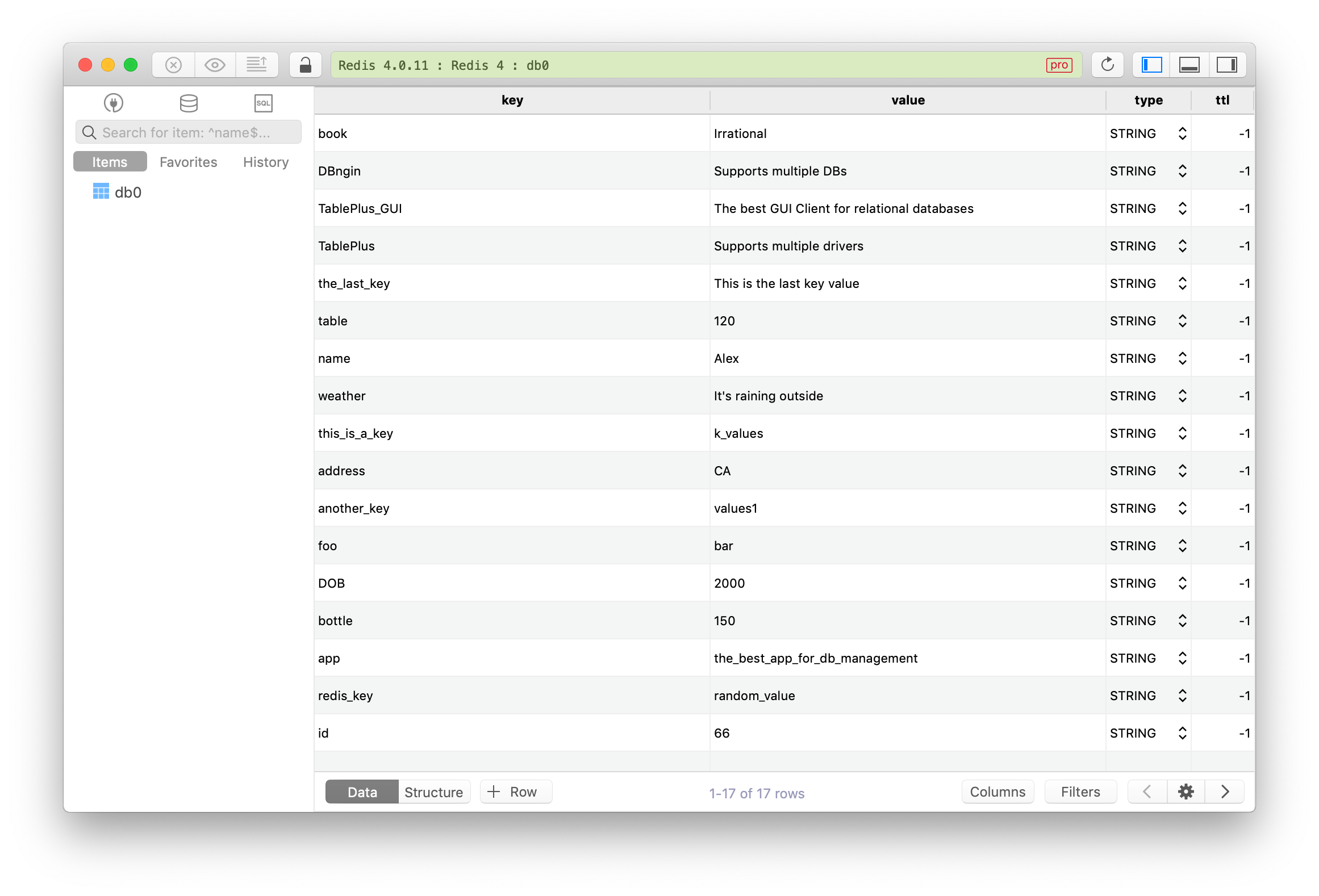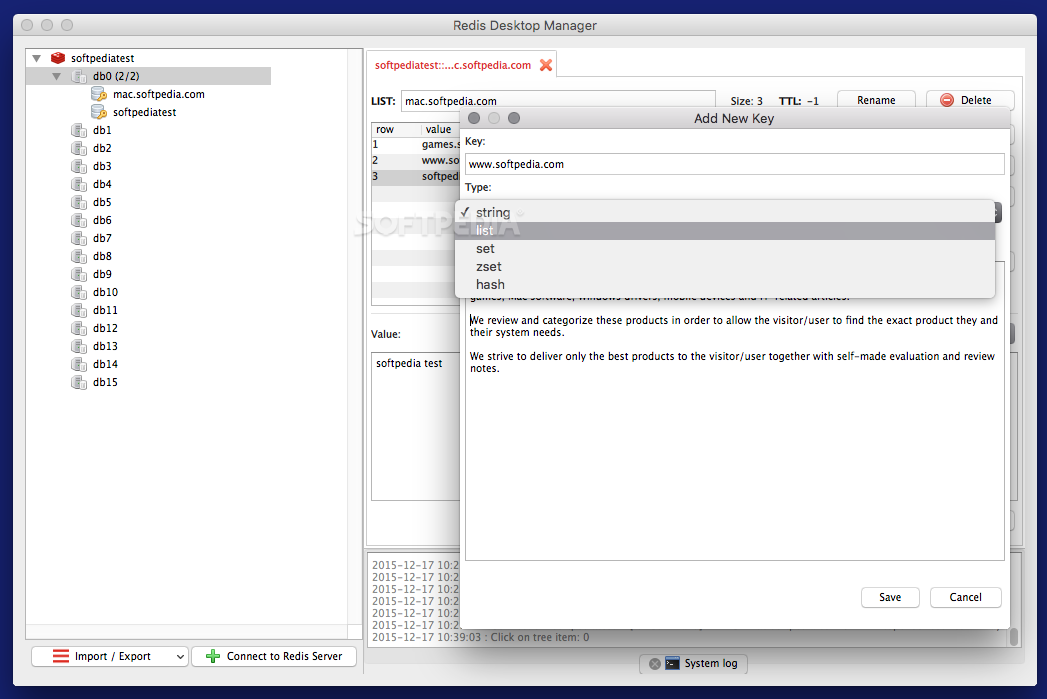Friday, I received a snazzy new M1 Macbook Pro in the mail. This article outlines how I was able to set it up for doing web development. We'll set up Homebrew, PHP, MySQL, Composer, and Laravel Valet. Let's jump in!
Redis Tool For Mac Osx
The previous article outlines first impressions from the perspective of someone upgrading from a 2013 mac.
Setting up an M1 mac for PHP development is not much different than other macs. Unless you're using Docker, which doesn't work on the new ARM processor (yet — they're working on it). I expected to have way more problems being an early adopter, but Apple has done a wonderful job with their Rosetta 2 translation layer. It mostly feels invisible, so (except for a few terminal commands like homebrew) you hardly even notice it is there.
Homebrew
Redis Commander worked really well for my very simple needs. Needed something very simple to use and also free ($). Does not have many frills but allows you to connect to a redis database, view and manage keys/value pairs and that is about it. Also has a redis cli built in which could be convenient as well. – shaune Jun 27 at 15:52. The developer is responsive to bug reports. Definitely this is the best tool I've found to date for managing remote Redis clusters from macOS. Developer Response, UPD: Bug with SSH keys was fixed in 2019.4.64. Please update RDM. Thanks for the bug report. FastoRedis (fork of FastoNoSQL) - is a cross-platform open source Redis management tool (i.e. It put the same engine that powers Redis's redis-cli shell. Everything you can write in redis-cli shell — you can write in Fastoredis! Disclaimer: I am the main developper of this tool.You can try - crossplatform Redis GUI client based on redis-cli. Right now FastoRedis work on most Linux platforms, FreeBSD, Windows and Mac OS X.It currently has next features. Full Power of Redis Shell. Multiple Shells. Text/Table/Tree result views. Full utf-8 support.
First, we'll need to install Homebrew. They don't have an ARM-compatible build ready yet, so this is where we'll need to use some Rosetta flags on the command line.
Install Rosetta on the command line with the following:
/usr/sbin/softwareupdate --install-rosetta --agree-to-license
Next, add this function to your .zshrc file. It makes a nice arm alias for running commands with x86_64 architecture flags. Perhaps calling it x86 would be better? Shoutout to Matt Stauffer for posting this.
You'll need to run the homebrew commands with this prefix for now. We can copy the script from their site, add our arm prefix, and homebrew should install!
PHP, MySQL, and Composer
Now that homebrew is installed, the rest of the Valet install is pretty much stock (except for Redis, which we'll get to in the next section).
PHP

Just run arm brew install php — it's that easy! You may want to restart your terminal after this.
MySQL
Normal besides the arm prefix again.
Composer
Run the download script from Composer's website, then move the PHAR file to the bin folder. Also we'll add the global composer vendor folder to our system path.

Now add the following line to your .zshrc file
Redis Gui Tool For Mac
Valet and Redis
Installing Valet should work as normal now. Run the following commands:
After that, I also ran cd ~/Code && valet park . Razer game booster mac download.
Installing Redis
Redis presented the only real speed bump I've encountered thus far. It installs via brew, but starting the Redis server doesn't work correctly (even though brew says it does). Until then, we can start the server manually.
First, run arm brew install redis to install it.
Next, install the Redis PHP extension with PECL — pecl install redis.
Starting the Server

Normally you'd use arm brew services start to start Redis (and at login), but it's not working yet. That command just runs redis-server under the hood. For some reason, this command only works with sudo right now. The workaround is to run this to start Redis server as a daemon:
Cleaning up after PECL (optional)
By default, PECL plops a new extension='redis.so' line at the top of the main php.ini file. I prefer to move this line to its own extension file. These steps are optional, but it's more in line with how extensions should be loaded in modern php versions.
Remove the extension='redis.so' line that PECL added at the top of /usr/local/etc/php/7.4/php.ini.
Then create a file at /usr/local/etc/php/7.4/conf.d/ext-redis.ini with these contents:
After doing all of this, I'd recommend running valet restart. Enjoy developing Laravel apps on your new mac!

If you encounter any problems or have any thoughts about this process, reach out to me on Twitter, I'd love to hear about them!
Redis Tool For Mac Installer
